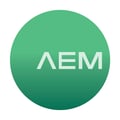KB14-B Creating Custom Labels and Integrating with Brady Express Labels Mobile (ELM) or Brady Workstation (BWS)
Should you wish to create custom labels on a PC and import them into the TestPro or Network Service Assistant Labeling Schemes, the list can be created in Excel and other spreadsheet programs and imported. You can also import the created label file into Brady’s Express Labels Mobile or Brady Workstation. This article will cover the AEM process first, followed by the Brady information. The instructions which follow are for Excel. Please refer to instructions of other spreadsheet programs for file creation details, the import process would be the same.
- Launch Microsoft Excel and add the labels you wish to create in column A. Click File > Save As > File Name: (enter desired file name) and Save As type: CSV (MS-DOS) (*.csv) and choose save location.

- Insert a USB drive into the PC. Open the TestDataPro PC software and select “Tools” tab. Click on “Import Custom Label”.

- Navigate to the folder where the .csv file is saved; select it then click “Open”.

- Click the dropdown arrow and select the USB drive letter, then click “OK”. In the confirmation notice that the custom label was created, click “OK”. This will create a folder on the USB drive named “CustomLabel” and the .csv file will be in this folder. Note: multiple .csv files may be imported simultaneously by selecting the files you wish to import.

- Remove USB drive from PC and insert into the side of powered up TestPro Main unit, or NSA. When the USB menu appears, select “Import Label List”. Next, select the label list or lists you which to import into your TestPro or NSA and click “Yes”. When the notification appears indicating label list successfully imported, click “Close”. The USB drive may be removed, then hit the “Back” button or the “Home” button to return to the main menu.

- Next, we’ll add the custom label scheme we just imported to our project profile. From the Home screen, select “Project”, if you are already in the correct project, select “Edit test profile”. (To change projects, select “Project Manager” and choose the correct project before editing test profile.) Select “Label Scheme”.

- The current label scheme will be shown, select “Edit” to change label scheme. Select the new label scheme from the list and click “Save”. The selected label scheme will appear, the scroll bar can be used to review the list if desired. Click the “x” to close the notification. The selected label list is now shown in the project profile and will be used during testing.

For additional information on project profile settings, please refer to the TestPro or NSA User Guide, quick start videos or contact technical support at customercare@aem-test.com.
Brady Express Labels Mobile Process
- Create .csv label scheme as outlined above.
- Follow the easy instructions in the short video at this link:
Brady Workstation Process
- Create .csv label scheme as outlined above.
- Importing a .CSV File into Brady Workstation Apps
- This functionality is provided by the Advanced Import plugin. As of Shell version 4.11 Advanced Import is provided by default with the full version of Custom Designer, the Print Partner app or Text Labels. .CSV import is not available using the Excel Import plugin from Custom Designer Lite.
- Note: This example shows how to import .CSV data into a label file. In order to use this functionality in Print Partner you would first need to create a label template. For more information see: Templates vs Label Files in Brady Workstation
Import Procedure
- Select the Advanced Import plugin available in Text Labels or Custom Designer.

- Select the Spreadsheet option.

- Navigate to and select your .CSV file.

- Click Finish

- Drag and drop data into the label canvas as needed. Dragging the data from the top entry in a column populates all data below into subsequent columns. Select "Place All" will automatically import the first 10 columns.

NOTE 1: Current "Place All" functionality puts the all the fields from row one onto the label, BUT, they will be placed from top to bottom with each subsequent line moved to the right. You will then need to move them where you want. AND, if using a template, Place All will put the data onto the template as described in previous sentence and will NOT be placed into placeholder fields.
NOTE 2: Refresh values options (bottom left of screen above) only works if the data source file name (for example: *.xlsx or *.csv) and location are the exact same as the previous import - in a Brady Workstation FILE (*.bws) - not a template (*.bwt). Since templates, once populated with data, cannot be saved as of yet, the Refresh when Label File Is Opened option does not apply, since when you open a template, it is blank. If you have the template open while you are make changes to your data source file and save the data source file, if Refresh Values when this file is printed is checked, when you click on Print, the data already dragged into the template fields will update.
For additional information on the importation process using Brady Workstation (BWS), please see the following links:
- https://support.bradyid.com/s/article/Custom-Designer-Advanced-Import
- https://support.bradyid.com/s/article/How-to-Import-Excel-Data-into-a-Label-File-in-Custom-Designer
To download a PDF of this article, click the link below.

